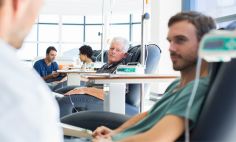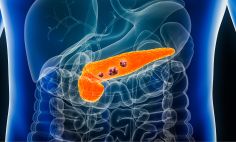Health Topics

When there’s research, there’s hope
Living with a rare disease called relapsing polychondritis
The first sign Meredith Winchell noticed was trouble breathing. At the time, she worked as an analyst at NIH. First, she started losing her breath just walking down a hallway at work. Then new symptoms started showing up, and they kept getting worse. Five years later, after countless doctor’s visits, diagnostic tests, and trips to the emergency room, she was diagnosed with a rare disease called relapsing polychondritis.
Relapsing polychondritis – “RP” for short – causes widespread inflammation (pain and swelling). It also breaks down cartilage (the tissue that protects your bones and joints) in certain parts of the body.
Common symptoms include:
- pain and swelling in cartilage (especially in ears and nose);
- pain, redness, and swelling in joints;
- sore throat, neck pain, and hoarseness; and
- hearing loss, tinnitus (ringing), and dizziness.
Most people don’t know about RP, so Meredith has learned to ask, “do you know what that is?” when she meets someone new.
An invisible disease
RP is extremely rare, and like many rare diseases, RP is an invisible disease. Doctors don’t know what causes RP, and getting the right diagnosis and treatment is one of the biggest challenges for people who have it.
Without a biomarker (biological material that can measure and identify diseases), there’s no way to test for RP. This means that doctors need to rely on patients’ symptoms to diagnose it. Unfortunately, RP can cause different kinds of symptoms in different people. Symptoms also don’t always seem related to each other, and they can come and go. For example, Meredith said her ear isn’t inflamed right now, but that doesn’t mean it won’t be in the next few hours or days.
Classic symptoms led to diagnosis
When Meredith first visited the doctor for her breathing problems, doctors told her she had asthma and gave her albuterol (an inhaler that relaxes and opens the airways to the lungs). When that didn’t work, they tried a steroid inhaler, which helped a little.
Along with trouble breathing, Meredith had extreme pain and inflammation in her stomach area, colon, and digestive tract and in her skin, joints, and sternum (the cartilage that connects the ribs). She took tests to find out what was wrong, but the tests didn’t give enough information to either diagnose or rule out any disease. One doctor told her it must be anxiety.
Meanwhile, her symptoms became so bad that she had to stop working. During an especially painful flare-up she went to the emergency room four times in a month. Luckily, a doctor there recognized the most common and visible RP symptoms – ear, nose, eye, and joint inflammation – and sent her to a rheumatologist (a doctor who specializes in joint, muscle, and bone diseases). The rheumatologist took one look at her and knew it was RP.
Disease impacts every part of life
Meredith considers herself lucky. She knows other people with RP whose diagnoses took even longer than hers. But getting diagnosed was just one part of her journey. Because there aren’t any treatments designed specifically for RP, doctors typically try giving RP patients therapies that work for other rheumatic and autoimmune diseases with similar symptoms. Sometimes they work, but not always.
Meredith’s RP and the side effects from its treatment impacts every part of her life. Her work was an important part of her identity before she got RP, and it’s hard not being able to work full time anymore. The medications she takes to help with inflammation suppress her immune system, which makes her more likely to get infections.
In each moment, she’s constantly adjusting her breath, her body, and her interactions to help her stay within her limits. “There’s never a time I’m not thinking about my disease,” she says.
Support from people who know what it’s like
Meredith joined her first RP Awareness support group on Facebook a few days after her diagnosis. Now she’s part of several Facebook groups for RP patients, doctors, researchers, and caregivers from countries around the world. They talk about research and raising awareness about RP. For Meredith, these groups are a way to stay informed about what’s happening in RP research and advocacy in other countries. But they also look out for each other, and Meredith says there’s nothing like the understanding and support from people who know what it’s like to live with RP.
Offline, Meredith’s biggest supports are her family and friends, her husband Dillon who she calls her “rock and caregiver,” and the talented doctors who work together to plan her care. She’s especially grateful for her rheumatologist Dr. Paola Pinto and NIH RP researcher Dr. Marcela Ferrada.
When there’s research, there’s hope
On the days when her symptoms are the worst, Meredith reminds herself of something Dr. Ferrada often says: “where there’s research, there’s hope.”
When Meredith was first diagnosed, most of what we knew about RP was based on old research from the 1970s. Luckily, that’s changing. Today, we know much more about who gets RP and its symptoms. Meredith says it’s easier now to find good, clear information on RP.
But there’s still so much we don’t know. Most importantly, what causes RP, and how it evolves. That’s one reason Meredith became involved in an NIH study led by Dr. Ferrada that follows people with RP over time. “Anything I can do to get more information and more data to get answers,” she says, “I consider a good day.”







